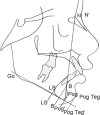Facial and dental alterations according to the breathing pattern
- PMID: 21552720
- PMCID: PMC4243757
- DOI: 10.1590/s1678-77572011000200015
Facial and dental alterations according to the breathing pattern
Abstract
There is controversy in the literature about possible interaction of the respiratory mode with the facial and dental structures.
Objectives: The aim of this study was to perform a longitudinal assessment of the changes in facial and dental structures in Angle's Class II, division 1 malocclusion individuals, divided according to the respiratory pattern (predominantly nasal or mouth), at two distinct moments of craniofacial development.
Material and methods: Pogonium and nose measurements were made on the lateral cephalometric tracings (LS'-Pog', LS'-B', B'-Pog', Pog'-PogTeg', Line NB, Pog-NB, N'-Prn, Prn-NPog, N-Prn-Sn, Prn-Sn-LS). Dental measurements were made on the plaster models (distances between the tips of the canine cusps and the tips of mesial cusps of the first molars) of 40 individuals aged 10 to 14 years (moment 1) and 13 to 16 years (moment 2), 23 being nose breathers (NB) and 17 being predominantly mouth breathers (MB).
Results: The Student's-t test and two-way ANOVA with repeated measures were applied to indicate differences between the mean values of these variables according to the moments and/or respiratory mode.
Conclusions: There were alterations in the facial measurements, without interference of the breathing pattern. However, the breathing pattern influenced dental alterations.
Figures
Similar articles
-
Transverse craniofacial dimensions in Angle Class II, Division 1 malocclusion according to breathing mode.Braz Oral Res. 2010 Jan-Mar;24(1):70-5. doi: 10.1590/s1806-83242010000100012. Braz Oral Res. 2010. PMID: 20339717
-
Sagittal and vertical aspects of Class II division 1 subjects according to the respiratory pattern.Dental Press J Orthod. 2013 Mar-Apr;18(2):30-5. doi: 10.1590/s2176-94512013000200011. Dental Press J Orthod. 2013. PMID: 23916429
-
Mouth breathing children and cephalometric pattern: does the stage of dental development matter?Int J Pediatr Otorhinolaryngol. 2012 Jun;76(6):837-41. doi: 10.1016/j.ijporl.2012.02.054. Epub 2012 Mar 14. Int J Pediatr Otorhinolaryngol. 2012. PMID: 22425033
-
Mouth breathing in children and its impact in dental malocclusion: a systematic review of observational studies.Minerva Stomatol. 2018 Jun;67(3):129-138. doi: 10.23736/S0026-4970.18.04015-3. Minerva Stomatol. 2018. PMID: 29879804
-
[The influence of breathing mode on the oral cavity].Pol Merkur Lekarski. 2015 Dec;39(234):405-7. Pol Merkur Lekarski. 2015. PMID: 26802697 Review. Polish.
Cited by
-
The role of craniofacial maldevelopment in the modern OSA epidemic: a scoping review.J Clin Sleep Med. 2022 Apr 1;18(4):1187-1202. doi: 10.5664/jcsm.9866. J Clin Sleep Med. 2022. PMID: 34984972 Free PMC article.
-
Alterations in maxillary sinus volume among oral and nasal breathers.Med Sci Monit. 2015 Jan 2;21:18-26. doi: 10.12659/MSM.891371. Med Sci Monit. 2015. PMID: 25553770 Free PMC article.
-
Dentofacial characteristics of oral breathers in different ages: a retrospective case-control study.Prog Orthod. 2015;16:23. doi: 10.1186/s40510-015-0092-y. Epub 2015 Jul 15. Prog Orthod. 2015. PMID: 26174032 Free PMC article.
-
Correlation between acoustic rhinometry, computed rhinomanometry and cone-beam computed tomography in mouth breathers with transverse maxillary deficiency.Braz J Otorhinolaryngol. 2016 Nov 25;84(1):40-50. doi: 10.1016/j.bjorl.2016.10.015. Online ahead of print. Braz J Otorhinolaryngol. 2016. PMID: 28017262 Free PMC article.
-
A cone-beam computed tomography study of hyoid bone position and airway volume in subjects with obstructive and nonobstructive adenotonsillar hypertrophy.Angle Orthod. 2023 Jul 1;93(4):467-475. doi: 10.2319/110822-769.1. Angle Orthod. 2023. PMID: 36928926 Free PMC article.
References
-
- Aksu M, Kocadereli I. Arch width changes in extraction and nonextraction treatment in Class I patients. Angle Orthod. 2005;75(6):948–952. - PubMed
-
- Bjork A. Variations in the growth pattern of the human mandible: longitudinal radiographic study by the implant method. J Dent Res. 1963;42(1):400–411. - PubMed
-
- Boley JC, Mark JA, Sachdeva RC, Buschang PH. Long-term stability of Class I premolar extraction treatment. Am J Orthod Dentofacial Orthop. 2003;124(3):277–287. - PubMed
-
- Brant JCO, Siqueira VCV. Soft tissue changes evaluated in Class II, division 1 cases, after orthodontic treatment. Rev Dent Press Ortodon Ortopedi Facial. 2006;11(2):93–102.
-
- Carter GA, McNamara JA., Jr Longitudinal dental arch changes in adults. Am J Orthod Dentofacial Orthop. 1998;114(1):88–99. - PubMed
MeSH terms
LinkOut - more resources
Full Text Sources
Miscellaneous





